Thinking about starting to use a 7 string guitar? Unsure where to begin? This guide covers everything a beginner needs to know about getting started with 7 string guitars…
7 String Guitar: Where Do We Start?
There was a time not too long ago, when “7 String guitar” was kind of a bad word. There was a stigma attached to it, that came mostly from Nu-Metal bands and their use of 7 Strings.
Bands like Korn put the 7 string guitar in the limelight for the first time really. For quite a few years, they were associated with over-simplified playing… even though it was a virtuoso that designed it!
The 7 string as we know it today went through quite a few different iterations before it became the guitar we know today.
For the most part, the 7 string guitar has been around for almost 230 years in different forms. In fact, they have been used by Jazz guitarists for years as well. But these were rare cases, and not a mass produced guitar. These were cool guitar for sure…
But we are going to focus fire on the solid body electric models that popularized the idea. You know, the one that Steve Vai made popular.
A Brief History of The 7 String Guitar…
The 7-string guitar, a staple in modern progressive rock and metal genres, has a history that is both intriguing and filled with experimentation. Its journey from conception to its current form is a testament to the relentless pursuit of innovation by guitarists and luthiers alike.
The Kirk Sand Experiment: 1983
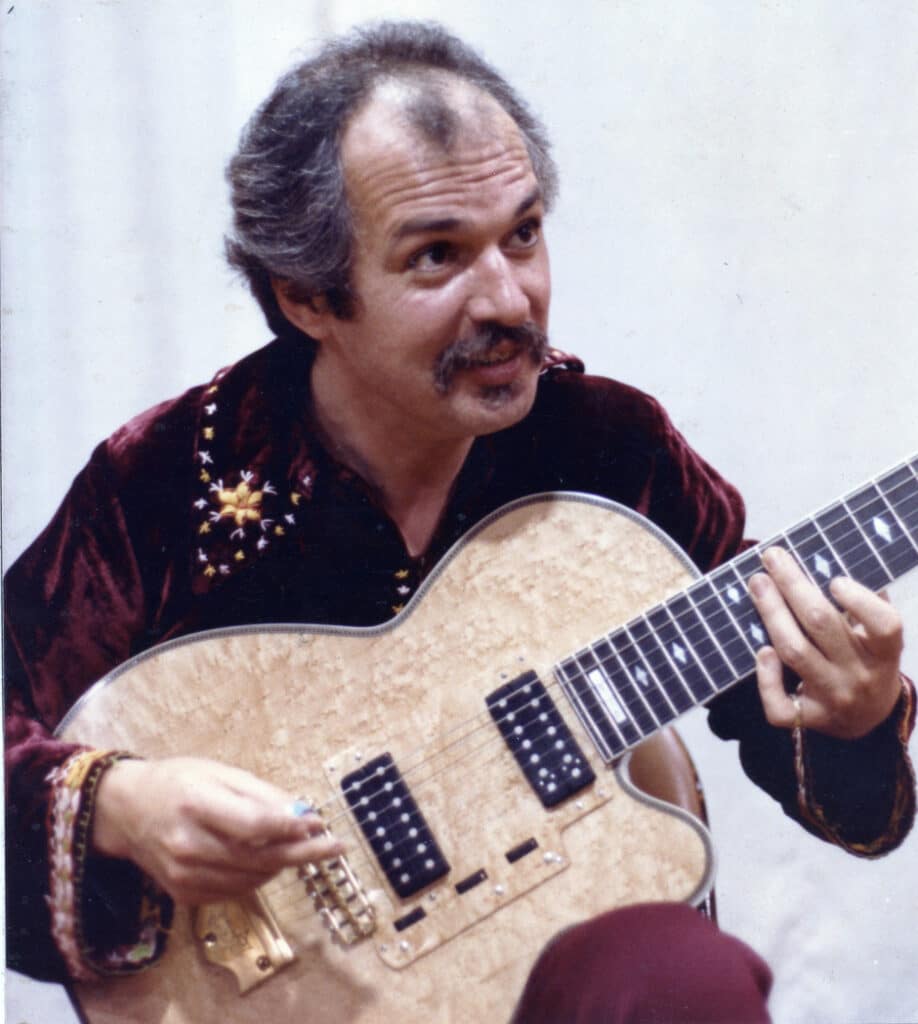
In 1983, a significant milestone in the evolution of the 7-string guitar was marked by luthier Kirk Sand. Collaborating with the legendary jazz guitarist Lenny Breau, Sand crafted what can be considered the first quasi-commercial 7-string guitar.
However, this instrument deviated from what most might imagine a 7-string guitar to be. Instead of adding a lower string to extend the bass range, Sand and Breau introduced a higher string above the traditional high E.
This additional string was tuned to A, a bold move that sought to expand the guitar’s treble range. However, this innovation was not without its challenges.
The primary issue was the guitar’s scale length, a standard 25.5 inches.
At this length, the high A string was under immense tension, leading to frequent breakages. This problem became so persistent that the idea, despite its potential, was eventually shelved.
Steve Vai and Ibanez: A New Direction in the 80s

Fast forward to the mid-1980s, and the 7-string guitar concept was resurrected, this time by virtuoso guitarist Steve Vai.
Vai, known for his relentless pursuit of unique sounds and techniques, collaborated with the renowned guitar manufacturer, Ibanez.
Together, they embarked on a journey to refine and redefine the 7-string guitar.
After several prototypes and iterations, Vai drew inspiration from the world of jazz. Jazz guitarists had been using 7-string guitars, but with a low A string, offering them a broader harmonic palette.
Vai proposed a similar approach but opted for a low B string instead.
This decision was transformative. It provided guitarists with a deeper sonic range without the tension issues that plagued the high A string in Sand’s design.
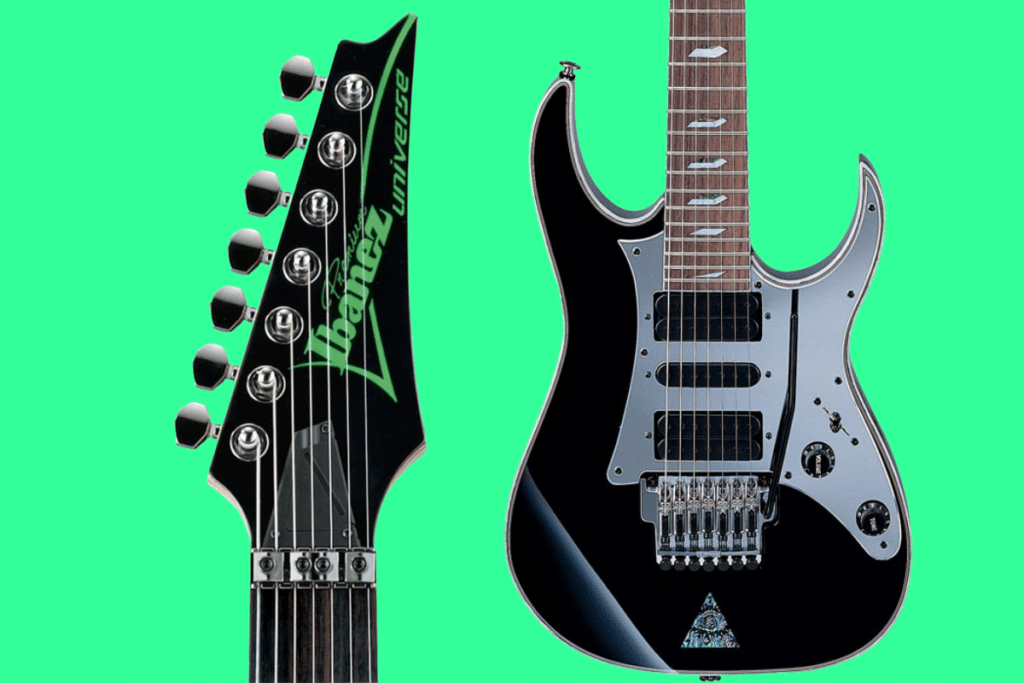
Steve Vai used the Universe 7 string for a couple of album cycles in the early 90’s and late 80’s. Most notably on the legendary album “Passion And Warfare” in 1991.
This put the 7 string guitar in the spotlight, and in the hands of a virtuoso.
These new Ibanez 7 string guitars were the first mass produced solid body guitars of their kind. Vai did some interesting things with them, but soon abandoned them.
Vai has gone on to use them again recently, but soon after his vision was realized, he put the 7 string guitars on the shelf in favor of his 6 strings. This left the used guitar market flooded with a ton of Ibanez Universe guitars.
Some other big names ended up using the Ibanez Universe, such as John Petrucci, Reb Beach, and a few other shredders from the 80’s. Ibanez halted production in the 90’s since the demand was non-existent.
Vai has been quoted saying that he knew someone would find a use for 7 string guitars, one day. That day came a lot quicker than he thought.
The Ibanez Universe: 1990 Onwards
In 1990, after rigorous testing and development, Ibanez launched the Universe series, the world’s first mass-produced 7-string electric guitar.
This guitar, with its extended low range, became an instant hit, especially among rock and metal guitarists.
The added depth of the low B string allowed for heavier riffs and more complex chord voicings, expanding the instrument’s versatility.
Statistics and Impact
The introduction of the Ibanez Universe series marked a significant shift in the guitar industry. By the late 1990s, sales figures for 7-string guitars had skyrocketed, with a growth rate of over 35% year-on-year.
Other major guitar manufacturers soon followed suit, introducing their own 7-string models.
Furthermore, the 7-string guitar’s impact on music genres was profound. Bands like Korn and Dream Theater adopted the instrument, pushing its sonic boundaries and inspiring a new generation of guitarists.
The Nu-Metal Years (Late 1990s to Mid-2000s)
The 7 string guitar was dead in the water by 1993, with even it’s creator leaving it behind. With so many of the guitars floating around the market though, a few different bands picked them up. But by far the most notable of these bands is Korn.
Korn seemed to come out of nowhere in the 90’s. The band was from Bakersfield, California. Their debut album took Metal, Rock, and hip hop influences to the absolute extreme.
Munky and Head from Korn had been told that the 7 string guitar was made for technical players, not people looking to just “riff”. The duo took on that challenge, tuning the 7 string down a full step to A standard.
Korn’s debut album became a huge success, and for the first time in a few years, Ibanez was back in the spotlight and making new 7 string models. Ibanez even made signature guitars for the guitarists of Korn, called the K7 .
Nu-metal took off, frosted tips became a thing, trousers became baggy, and Dickies made a mint selling cargo pants. And most of it was all down to Korn. For guitar companies like Ibanez, it was like Christmas had come early: by the mid-2000’s tons of bands had embraced the idea of 7 strings.
The Modern Era: Djent, Technical Prog & Periphery
These days, almost every “Metal” guitar company makes a few 7 string models. They have gained huge huge popularity and are used by technical players, as well as people similar to Korn, that use them for “riffing”.
Bands like Periphery breathed new life into the instrument, putting the 7 string guitar right back where it started: in the hands of technical players and Progressive Rock/Metal virtuosos.
Companies like Schecter, Ibanez, and Dean make tons of 7 string models every year and they continue to sell extremely well.
And that’s great. Tonally, you can do plenty with a 7-string that just isn’t possible with a standard, 6-string guitar. You can tune lower, access extended tonal ranges, and – if you want to get heavy – you can get insanely heavy with one.
But if you’re coming from a 6-string guitar to a 7-string, the first thing you’re going to have to get your head around is the different tunings. Standard Tuning on a 7-string is, of course, slightly different to Standard Tuning on a 6-string.
7 String Guitar Standard Tuning: An In-depth Exploration
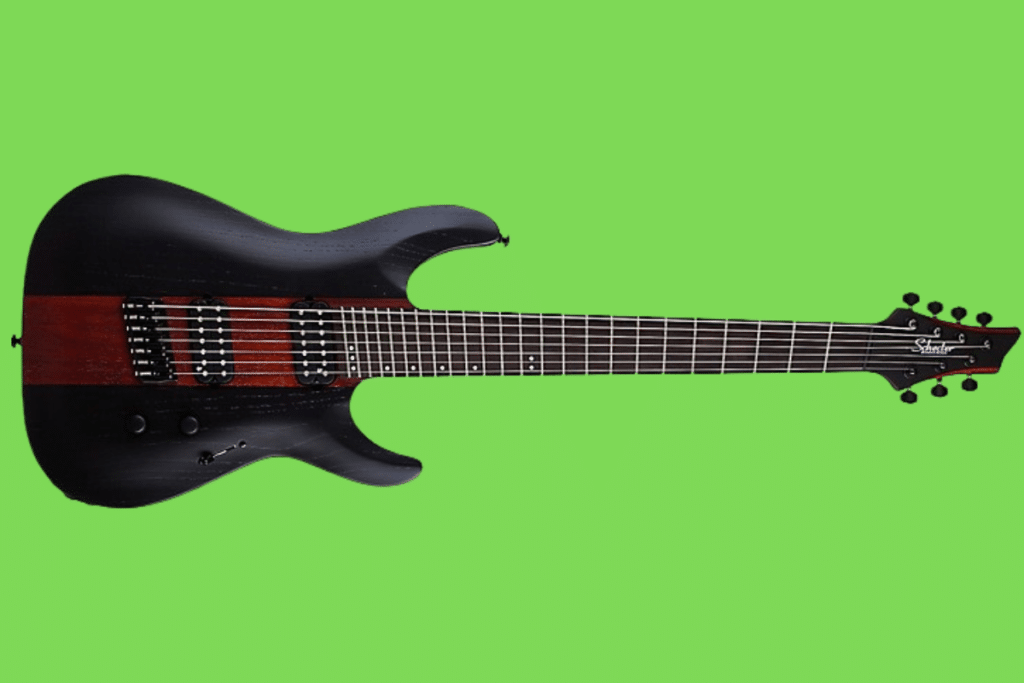
A 7 string guitar, with its additional string, offers guitarists a broader range of tonal possibilities.
But with the added string comes the question of tuning.
How do you tune a 7 string guitar? Let’s dive deep into the standard tuning of a 7 string guitar and explore its nuances.
Before we delve into the specifics of tuning, it’s essential to understand the history of the 7 string guitar. Originating in Russia in the early 19th century, the 7 string guitar was initially tuned to an open G chord.
However, as the instrument found its way into jazz, rock, and metal genres, the tuning evolved, and the modern standard tuning emerged.
The Standard Tuning
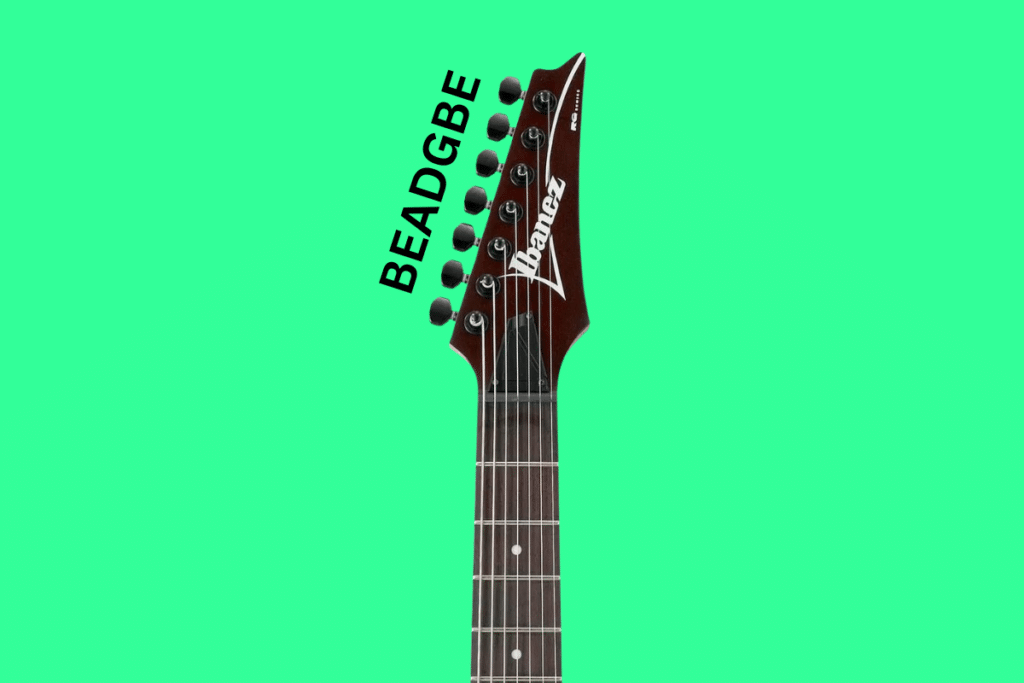
The standard tuning for a 7 string guitar, starting from the thickest string (lowest pitch) to the thinnest string (highest pitch), is:
- B1
- E2
- A2
- D3
- G3
- B3
- E4
This tuning adds a low B string below the standard 6 string guitar tuning. The additional B string expands the instrument’s range, allowing for deeper bass notes, which is especially favored in genres like metal and progressive rock.
The Rationale Behind the Tuning
The addition of the low B string in the standard tuning provides guitarists with the ability to play more complex chord voicings and riffs that wouldn’t be possible on a 6 string guitar. This extended range is particularly beneficial for rhythm guitarists and those who play in drop tunings. The low B can also be used to play bass lines, making it a versatile tool for solo performers.
Alternate Tunings
While the B-E-A-D-G-B-E tuning is standard, many guitarists experiment with alternate tunings to achieve unique sounds.
Some popular alternate tunings for the 7 string guitar include:
- Drop A: A-E-A-D-G-B-E
- Open C: C-G-C-G-C-E-D
These tunings can offer different tonal landscapes and can inspire new ways of approaching the instrument.
Challenges and Considerations
Tuning a 7 string guitar, especially for those accustomed to a 6 string, can present some challenges. The added string can require adjustments in playing technique.
The increased tension on the neck from the additional string can necessitate periodic setups and adjustments to ensure the guitar plays correctly.
When selecting strings for a 7 string guitar, it’s crucial to choose a set designed for the extended range. The low B string, in particular, needs to be thick enough to produce a clear tone without being too floppy.
7 String Guitar: Uses & Pros – Why They’re Awesome
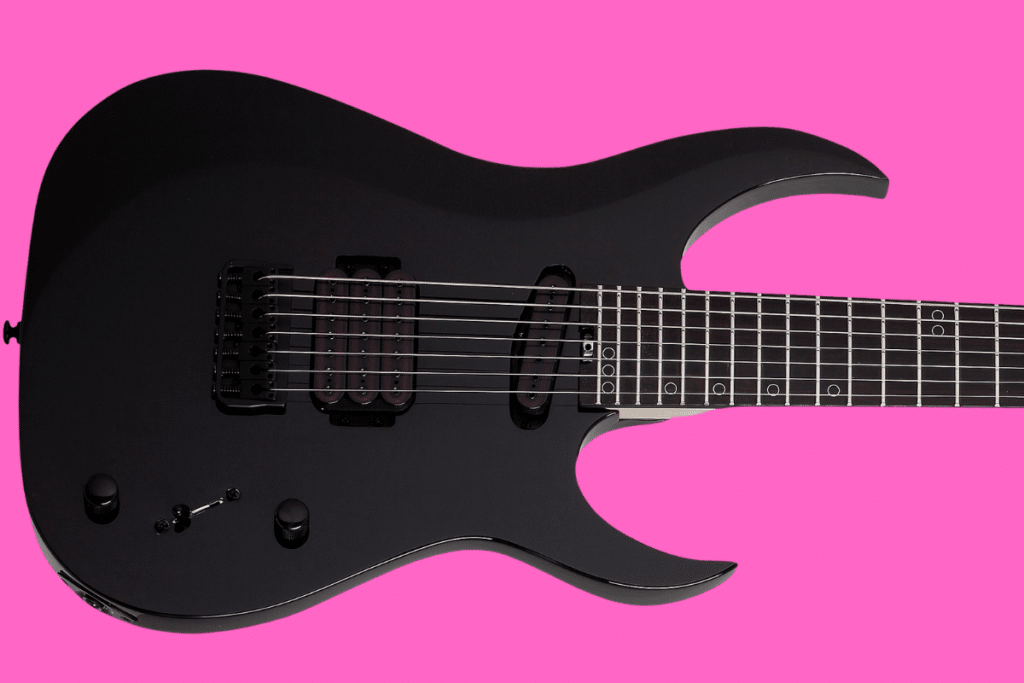
So what are the advantages and disadvantages of playing a 7 string guitar? How do you use one?
A lot of people get really intimidated by the idea of 7 strings, but there are tons of ways to utilize the extra string. Most players these days tune down, and that’s one way to use them. With the advent of Fan-Fret 7 strings, it’s never been easier to tune down really low.
But the standard tuning that we mentioned earlier is still really valid.
This is personally how I like to use my 7 string. Standard tuning gives you not only lower range, but it also gives you different ways to play scales and modes.
You can use the low B as an anchor point for starting a run, or you can use the lower notes to end a run. Either way, it adds a different flavor to your playing.
Some players view a 7 string as “just a six string with an extra string”. I think this is a pretty inaccurate approach.
The 7 string is a totally different instrument, and should be looked at as such. I believe you should look at the 7 string as a new guitar experience, and use the lower string for more than just riffing lower notes.
No matter how you want to use it, the 7 string guitar definitely opens up different possibilities! This can boost your creativity, as I have said before regarding tunings. I use the 7 string as a different “color” for my instrumental palate. I think this is a huge advantage!
7 String Guitar: Is It For You?

If the thought of an extra string sounds intimidating, you’re not alone. But here’s the kicker: The 7-string guitar might just be the boost your musical journey needs. And no, it’s not as daunting as it sounds.
That’s why plenty of 7-stringers move on to 8-string and even 9-string guitars – they get hooked on that extended range of tonal options.
Things To Keep In Mind:
- 🎸 First Impressions vs. Reality: When I first picked up a 7-string guitar, I won’t lie – it felt a tad overwhelming. But guess what? In just a mere five days, I was jamming as if I’d played it for years. So, if you’re hesitant, know this: the transition is smoother than you think.
- 🔑 Unlock Untapped Creative Potential: This isn’t just about one extra string. It’s a portal to a world of musical magic. Think about it – unique chord structures, resonating bass notes, and melodies that dance in a way you hadn’t thought possible. It’s like upgrading your toolkit with a shiny new tool that has multifaceted uses.
- 🤷♂️ Not For Everyone? Totally Fine: Music is deeply personal. I’ve jammed with legendary guitarists who’ve dabbled with 7-strings, only to realize it wasn’t for them. And that’s perfectly okay. Your instrument should resonate with your style, not dictate it.
Bottom Line? Music thrives on variety. Whether you’re Team 6-String or considering joining Team 7-String, it boils down to personal taste and musical goals.
But here’s my two cents: don’t let the unknown hold you back. Dive in, experiment, and let that 7th string potentially redefine your musical boundaries.
7-String Guitar Reviews: ELECTRIKJAM’s Recommended Picks
And if you’re interested in making the switch, here’s some reviews of my favorite 7-string guitars that I have either bought or tested during the last 12-18 months:


Leave a Reply